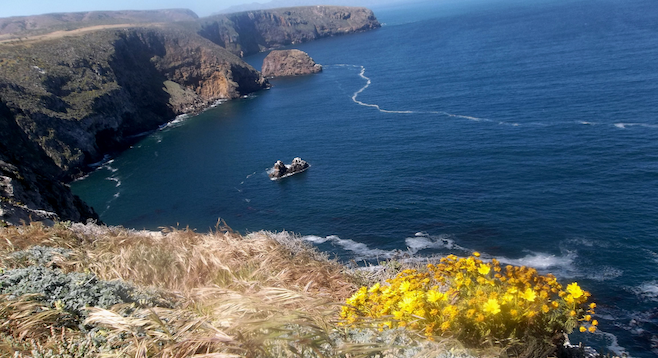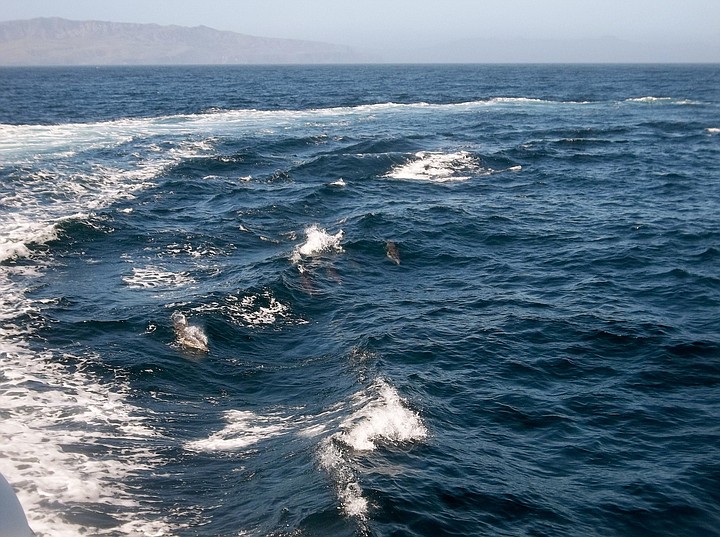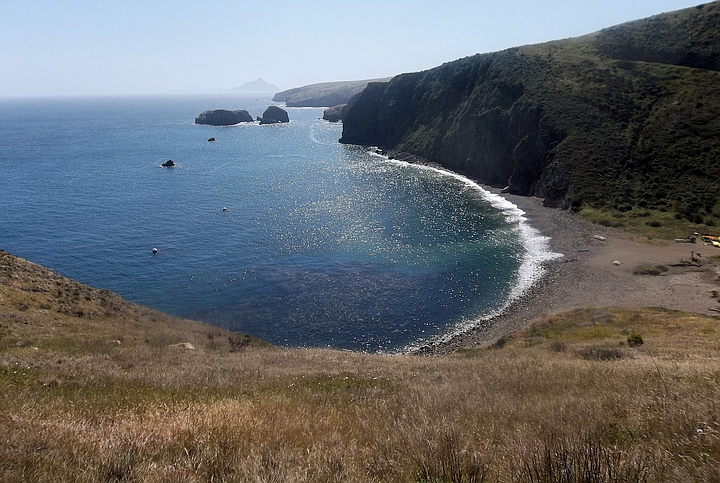 Facebook
Facebook
 X
X
 Instagram
Instagram
 TikTok
TikTok
 Youtube
Youtube

Visiting Channel Islands National Park is like entering a time machine and being transported back a few hundred years to a wild and natural, pre-automobile, pre-industrial California.

Located off the coast of Ventura, the Channel Islands are sometimes called the North American Galapagos Islands for their diversity and uniqueness of plant and animal life. I visited Santa Cruz, the largest of the eight islands in the chain.
During the hour-long boat ride there, courtesy of Island Packers, we were joined by a pod of dolphins skirting friskily alongside our boat.
Upon arriving at the island's Scorpion Ranch stop, a volunteer guide gave us a brief orientation: “Nothing you bring can stay on the island. Leave no food behind or unattended.” These admonitions underscore the efforts to preserve the islands in their natural state.
Hiking is the most popular activity on a day trip, and there were a variety of hikes to choose from. You can go by yourself or with a naturalist on a guided walk. This part of the island is operated by the National Park Service, while the larger part is run by the Nature Conservancy. Those arriving at Prisoners Harbor, run by the Nature Conservancy, must take walks accompanied by a guide. I chose to hike up to Cavern Point to enjoy spectacular views along the edge of the cliffs.
As we hiked high above the Pacific, we could detect a pod of more than a dozen gray whales just below the surface of the water. We walked under a warm spring sun admiring the scintillating ocean vistas and wildflowers dotting the edge of the cliffs. A soft breeze joined us, and I felt a serenity and communion with the ecosystem of the island.
If I had known how rewarding this visit would be, I would have come here years earlier. The islands have flown under the radar of most Californians – certainly compared to the state’s other national parks. This, no doubt, contributes to its charm.
“How do you get there?” asked a well-traveled friend of mine upon hearing of my trip.
Although relatively undiscovered by Californians, the Channel Islands had been inhabited by the Chumash for nearly 10,000 years. Then the Europeans arrived in the 1700s, bringing with them diseases such as measles and syphilis that nearly wiped out the natives.

A small community of ranchers eventually developed at Scorpion Cove. Several ranch houses of that era still remain, including one converted into a Visitors Center. The ranchers also introduced several invasive species to the island.
I was intrigued to hear of the efforts that have successfully relocated most of the invasive species such as sheep, feral pigs and golden eagles that had tampered with the ecosystem. Native species such as bald eagles and island foxes have been largely restored. Several species of fauna and flora found in the Channel Islands exist nowhere else in the world. One such species is the island scrub jay, a small blue and white bird that's incapable of flying over a large body of water.
Island Packers offers bird watching and whale watching expeditions that visit here. Winter and spring are the seasons to spot migrating gray whales, while blue whales are commonly spotted in the summer and fall. A third of the world’s species of whales and dolphins populate the Santa Barbara Channel off the islands. The waters within a nautical mile of the island are protected, so fishing is prohibited.
Some of the best snorkeling and diving opportunities in the world are here along the kelp beds. Other activities available to visitors to the islands include camping (the largest campground is at Scorpion Cove), hiking, kayaking, sailing, tidepool exploring, and surfing (although the surf spots are remote and most easily accessed by private boat).
Five of the islands are accessible through Island Packers: Anacapa, San Miguel, Santa Rosa, Santa Cruz and Santa Barbara. They charge $59 for adults and $41 for children to visit Santa Cruz or Anacapa, but the outer islands are a bit more expensive. Inspiration Point on Anacapa is said to have the single most spectacular view on the islands. The Channel Islands National Park Visitors Center is near the harbor in Ventura, and you can take a virtual tour of the islands on their website.
So visit here when you can and experience California in its natural state – just be sure to take back whatever you bring.


Visiting Channel Islands National Park is like entering a time machine and being transported back a few hundred years to a wild and natural, pre-automobile, pre-industrial California.

Located off the coast of Ventura, the Channel Islands are sometimes called the North American Galapagos Islands for their diversity and uniqueness of plant and animal life. I visited Santa Cruz, the largest of the eight islands in the chain.
During the hour-long boat ride there, courtesy of Island Packers, we were joined by a pod of dolphins skirting friskily alongside our boat.
Upon arriving at the island's Scorpion Ranch stop, a volunteer guide gave us a brief orientation: “Nothing you bring can stay on the island. Leave no food behind or unattended.” These admonitions underscore the efforts to preserve the islands in their natural state.
Hiking is the most popular activity on a day trip, and there were a variety of hikes to choose from. You can go by yourself or with a naturalist on a guided walk. This part of the island is operated by the National Park Service, while the larger part is run by the Nature Conservancy. Those arriving at Prisoners Harbor, run by the Nature Conservancy, must take walks accompanied by a guide. I chose to hike up to Cavern Point to enjoy spectacular views along the edge of the cliffs.
As we hiked high above the Pacific, we could detect a pod of more than a dozen gray whales just below the surface of the water. We walked under a warm spring sun admiring the scintillating ocean vistas and wildflowers dotting the edge of the cliffs. A soft breeze joined us, and I felt a serenity and communion with the ecosystem of the island.
If I had known how rewarding this visit would be, I would have come here years earlier. The islands have flown under the radar of most Californians – certainly compared to the state’s other national parks. This, no doubt, contributes to its charm.
“How do you get there?” asked a well-traveled friend of mine upon hearing of my trip.
Although relatively undiscovered by Californians, the Channel Islands had been inhabited by the Chumash for nearly 10,000 years. Then the Europeans arrived in the 1700s, bringing with them diseases such as measles and syphilis that nearly wiped out the natives.

A small community of ranchers eventually developed at Scorpion Cove. Several ranch houses of that era still remain, including one converted into a Visitors Center. The ranchers also introduced several invasive species to the island.
I was intrigued to hear of the efforts that have successfully relocated most of the invasive species such as sheep, feral pigs and golden eagles that had tampered with the ecosystem. Native species such as bald eagles and island foxes have been largely restored. Several species of fauna and flora found in the Channel Islands exist nowhere else in the world. One such species is the island scrub jay, a small blue and white bird that's incapable of flying over a large body of water.
Island Packers offers bird watching and whale watching expeditions that visit here. Winter and spring are the seasons to spot migrating gray whales, while blue whales are commonly spotted in the summer and fall. A third of the world’s species of whales and dolphins populate the Santa Barbara Channel off the islands. The waters within a nautical mile of the island are protected, so fishing is prohibited.
Some of the best snorkeling and diving opportunities in the world are here along the kelp beds. Other activities available to visitors to the islands include camping (the largest campground is at Scorpion Cove), hiking, kayaking, sailing, tidepool exploring, and surfing (although the surf spots are remote and most easily accessed by private boat).
Five of the islands are accessible through Island Packers: Anacapa, San Miguel, Santa Rosa, Santa Cruz and Santa Barbara. They charge $59 for adults and $41 for children to visit Santa Cruz or Anacapa, but the outer islands are a bit more expensive. Inspiration Point on Anacapa is said to have the single most spectacular view on the islands. The Channel Islands National Park Visitors Center is near the harbor in Ventura, and you can take a virtual tour of the islands on their website.
So visit here when you can and experience California in its natural state – just be sure to take back whatever you bring.
Comments